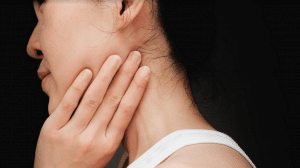Finding Relief From TMJ

What is TMJ?
The TMJ, which is an acronym for temporomandibular joint, is the jaw joint that allows patients to open and close their mouths. It is surrounded by muscles which can become painful if malfunctioning occurs. This malfunction is sometimes referred to as TMD, or temporomandibular joint disorder when it becomes a chronic issue. The condition can be diagnosed by a dental practitioner or a primary physician with a physical evaluation and a discussion of presenting symptoms.
What symptoms may indicate the presence of this condition?
TMJ/TMD symptoms include:
- Discomfort, pain, and tenderness in the jaw joints and surrounding facial muscles
- Chronic headaches/migraines
- Pain in the temples or throat, radiating down to the neck and shoulders
- Locking of the jaw joint
- Pain with chewing or yawning
- Clicking, grating, and popping sounds when eating
Each patient’s experience with TMJ/TMD differs, but these are the most common symptoms that may indicate a problem with the temporomandibular joint. If patients have any of these signs, they will want to speak with a medical or dental professional to get a proper diagnosis and to evaluate the best treatment option.
What causes TMJ/TMD?
For most patients, the development of this condition does not have a single, specific cause. Outside of trauma to the mouth and jaw, this condition can develop on its own without any known reason. Coexisting conditions may aggravate the joint including bruxism and arthritis and may be treated alongside the TMJ/TMD. Patients who are diagnosed with TMD must understand that this disorder is a chronic and degenerative condition that should be managed as soon as it is diagnosed, as well as over the course of time. Proactive treatment can reduce additional problems surrounding the jaw joint and alleviate common side effects and symptoms.
How is TMJ diagnosed?
The diagnosis of this condition is achieved with an evaluation by a dental or medical professional. The patient is asked to describe the problems they are experiencing while the doctor physically examines the mouth. Doctors may notice signs of coexisting conditions such as unusual wear on the natural teeth and routinely broken or chipped restorations. X-rays may be completed to evaluate the joint itself and the surrounding bone to spot any signs of damage, degeneration, or arthritis. With a proper examination, patients can obtain a trusted and accurate diagnosis and discuss a treatment plan that suits their needs.
What can be done for the pain?
For some of our patients, managing the pain with over-the-counter medications can help. With proper treatment, pharmaceuticals may not be required. Treatment options will vary depending on the severity of the condition.
What is the best treatment for TMJ/TMD?
TMJ/TMD may be treated in a variety of different ways. More severe stages of TMJ/TMD may require surgical intervention in the jaw joint. However, this is often the last line of defense only when alternative, non-surgical treatments have not been beneficial to the patient. Non-surgical solutions are designed for reducing pressure on the joints, decreasing pain, and allowing patients to maintain normal activity without discomfort including chewing and yawning. Patients can ask their medical provider about using gentle massage, electrical neural stimulation, or oral appliance therapy as a treatment for this condition.
Are there other possible coexisting conditions?
Some patients who have been diagnosed with this condition may also be diagnosed with bruxism. Bruxism is commonly coexisting in patients who have TMJ/TMD. This condition causes clenching and grinding of the teeth while patients sleep, which can wear down natural tooth enamel and break restorations such as dental crowns, porcelain veneers, and bridges. This condition may be addressed with an oral appliance that can treat both bruxism and TMJ/TMD simultaneously while protecting the smile from damage. Patients who have these coexisting conditions may also notice a reduction in tension around the joint and chronic headaches or migraines. Some patients who have TMJ/TMD may also experience pain from arthritis. This is why it is so important for patients to seek an examination with a professional if they suspect the development of TMJ/TMD issues.
Request your appointment with Dr. John G. Imm III today!
At 5 Points Advanced Dentistry, patients in and around the area of Upper Arlington, OH are welcome to schedule a consultation with our team to discuss the problems associated with TMJ/TMD and to find a solution that works. Call 614-451-5435 to make an appointment and visit the practice at 3380 Tremont Road.
